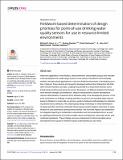Fieldwork-based determination of design priorities for point-of-use drinking water quality sensors for use in resource-limited environments
Author(s)
Bono Jr, Michael S; Beasley, Sydney; Hanhauser, Emily; Hart, Anastasios John; Karnik, Rohit; Vaishnav, Chintan H.; ... Show more Show less
DownloadPublished version (1.772Mb)
Publisher with Creative Commons License
Publisher with Creative Commons License
Creative Commons Attribution
Terms of use
Metadata
Show full item recordAbstract
Improved capabilities in microfluidics, electrochemistry, and portable assays have resulted in the development of a wide range of point-of-use sensors intended for environmental, medical, and agricultural applications in resource-limited environments of developing countries. However, these devices are frequently developed without direct interaction with their often-remote intended user base, creating the potential for a disconnect between users' actual needs and those perceived by sensor developers. As different analytical techniques have inherent strengths and limitations, effective measurement solution development requires determination of desired sensor attributes early in the development process. In this work, we present our findings on design priorities for point-of-use microbial water sensors based on fieldwork in rural India, as well as a guide to fieldwork methodologies for determining desired sensor attributes. We utilized group design workshops for initial identification of design priorities, and then conducted choice-based conjoint analysis interviews for quantification of user preferences among these priorities. We found the highest user preference for integrated reporting of contaminant concentration and recommended actions, as well as significant preferences for mostly reusable sensor architectures, same-day results, and combined ingredients. These findings serve as a framework for future microbial sensor development and a guide for fieldwork-based understanding of user needs.
Date issued
2020-01Department
Massachusetts Institute of Technology. Department of Mechanical Engineering; Massachusetts Institute of Technology. Department of Urban Studies and Planning; Technology and Policy Program; Sloan School of ManagementPublisher
Public Library of Science (PLoS)
Citation
Bono Jr, Michael S et al. "Fieldwork-based determination of design priorities for point-of-use drinking water quality sensors for use in resource-limited environments." PLoS ONE 15, 1 (January 2020): e0228140 © 2020 Public Library of Science
Version: Final published version
ISSN
1932-6203